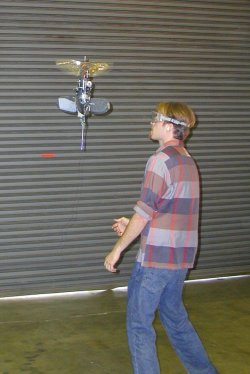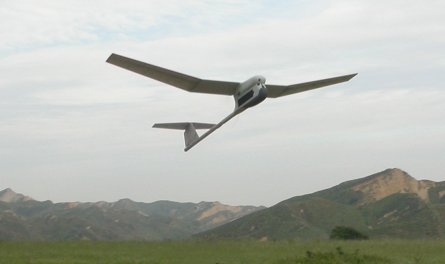A US Army Ranger squad leader watches video on his personal digital assistant as it streams from micro air vehicles (MAV) in his area. Hovering above the squad, a small ducted-fan unmanned air vehicle provides a view of the entire city block. Below it a hand-sized fixed-wing UAV has tracked a vehicle carrying suspected terrorists to a building and continues to loiter.
 The squad’s backpackable rotorcraft UAV inspects the building, hovering close to a window through which it launches a tiny flapping-wing MAV. This finds the room in which the suspects are located, sending video back to the squad leader who identifies them as terrorists and gives their GPS co-ordinates to a loitering armed UAV. Moments later a missile slams into the room.
The squad’s backpackable rotorcraft UAV inspects the building, hovering close to a window through which it launches a tiny flapping-wing MAV. This finds the room in which the suspects are located, sending video back to the squad leader who identifies them as terrorists and gives their GPS co-ordinates to a loitering armed UAV. Moments later a missile slams into the room.
This kind of scenario is driving research into smaller and smaller UAVs, capable of operating in streets, corridors and tunnels. They are referred to as “micro” air vehicles, but the term MAV covers a range of sizes. The US Defense Advanced Research Projects Agency (DARPA) has had two MAV programmes: one a 500g (1lb)-class vehicle; the other weighing almost 7kg. Now DARPA has added to the mix by launching a programme to demonstrate a 10g “nano” air vehicle (NAV).
The US Army’s European research office, meanwhile, staged a MAV competition in Garmisch-Partenkirchen, Germany last month that specified a 500g maximum weight, a longest dimension (span or length) of no more than 500mm (20in), a minimum range of 500m (1,600ft) and target flight endurance of 30min. This attracted 16 entries: 12 fixed-wing vehicles, three mini-rotorcraft and one flapping-wing MAV. A second US/European MAV competition is planned for October next year at Eglin AFB, Florida.
Field testing
DARPA’s first MAV programme, launched in 1997, resulted in the AeroVironment Wasp, a battery-powered, radio-controlled flying wing weighing 170g, with a 330m wingspan and an endurance of around 1h. The Wasp is now being field tested by the US military, as is the later, larger ducted-fan MAV, a 6.8kg autonomous vehicle developed by Honeywell and powered by a heavy fuel engine, with a range of 10km and endurance of 40min.
The agency’s new NAV programme returns to the territory explored by its original micro-scale effort, but sets even more challenging requirements that are likely to be met only by flapping- or rotary-wing air vehicles. “A few of the MAV bids were in the nano air vehicle scale, but they were not mature at the time and did not work well,” says Darryl Pines, NAV programme manager. “But MAV provided an impetus, and eight to 10 years later we have a better understanding of the fundamental physics of how insects and birds fly.”
The requirement has also matured, with US operations in Afghanistan and Iraq revealing the need for UAVs small enough to operate inside buildings, caves and tunnels. “MAVs are too big. We need something even smaller,” says Pines. “The NAV programme provides a clear direction for development of a system that is useful to the warfighter.” DARPA is looking for a vehicle no bigger than 75mm in any dimension, weighing no more than 10g, with the ability to fly 1km at 7-10m/s (15-20kt/25-35km/h), loiter at 0.5m/s for more than 60s then hover in place for another minute or more, sending video back to the operator.

As the first generation of micro-scale UAVs, exemplified by the remote-control Wasp, reaches the hands of military users, the US Army’s MAV competition in Garmisch-Partenkirchen provided a glimpse of the future. The winning University of Arizona team’s fixed-wing MAV transmitted video while flying autonomously via GPS waypoints using an open-source flight-control software package, called Paparazzi, originally developed by France’s national aviation school Enac.
The UAVTech group, led by Sweden’s Linkoping University, won the rotorcraft award as its LinkMAV platform was the only one to complete the competition scenario, which involved flying several hundred metres to a virtual building then identifying a terrorist target. But the sole flapping-wing MAV in the contest, Delft University of Technology’s DelFly, was able to fly through a window and achieve a near hover, the team says.
Development impetus
 Technologies for the type of vehicle DARPA is seeking have been under development for years in university laboratories, but the NAV programme is intended to provide the impetus to integrate them into a vehicle with military utility.
Technologies for the type of vehicle DARPA is seeking have been under development for years in university laboratories, but the NAV programme is intended to provide the impetus to integrate them into a vehicle with military utility.
“We want a complete system. This is not just a technology programme,” says Pines. The major challenges are the small size – which was increased from 50mm to 75mm before potential bidders were briefed earlier this month – and the weight, which at 10g is heavy for such a small vehicle, experts say.
There are several approaches to producing a nano or micro air vehicle that can hover, or perch and stare. AeroVironment has developed the 180g Hoverfly MAV, a battery-powered flying wing with coaxial “proprotors” that allow it to take off and land vertically, hover for more than 7min, transition to forward flight and cruise for more than 13min. The company has also tested the MicroBat, a battery-powered flapping-wing ornithopter with a mass of 12g and endurance of just over 2min.
Weighing just 17g, the Netherlands-developed DelFly uses its flapping wings, which are arranged in an X, to produce both lift and thrust, and is capable of extremely low speed, but not a true hover. The US Naval Research Laboratory has developed the Samara, a 300g battery-powered stop-rotor vehicle that uses a pair of overlapping, counter-rotating single-blade rotors that resemble the samara seed of the maple, which descends like a helicopter when it falls from the tree.
The Mentor MAV, developed by SRI International and the University of Toronto, is a flapping-wing helicopter that uses the “clap and fling” effect exploited by butterflies, moths and even pigeons, where lift is generated by the compression and suction caused by clapping the wings together and flinging them apart. Equally exotic is the Georgia Tech Research Institute’s (GTRI) insect-inspired Entomopter, a 150mm-span X-wing MAV that uses a reciprocating chemical muscle (RCM) not only to flap the wings, but to generate electrical power and produce gas for circulation control on the wings that provides roll control.
Some of those ideas will be candidates for DARPA’s NAV programme, but moving from laboratory to field testing is likely to prove a major challenge. “Size, not weight, is the issue,” says Kevin Jones, associate research professor at the Naval Postgraduate School in Monterey, California, who has been working on flapping-wing MAVs for more than 10 years. “The critical issue is Reynolds number,” he says.
 Reynolds number (Rn) is an aerodynamic term that describes the ratio of inertial to viscous forces in air, and is related to the speed and scale of the air vehicle. Full-size aircraft have Reynolds numbers ranging from a few million to around 70 million for the Boeing 747. A fruit fly has an Rn of around 500. For MAVs the number is around 100,000, and for a nano air vehicle it could be “a few thousand”, says Jones.
Reynolds number (Rn) is an aerodynamic term that describes the ratio of inertial to viscous forces in air, and is related to the speed and scale of the air vehicle. Full-size aircraft have Reynolds numbers ranging from a few million to around 70 million for the Boeing 747. A fruit fly has an Rn of around 500. For MAVs the number is around 100,000, and for a nano air vehicle it could be “a few thousand”, says Jones.
“When the Reynolds number is very large, the inertia of the air is very significant and its viscosity is insignificant. As it gets smaller, viscosity and skin friction become critical and flow separation becomes the predominant feature,” says Jones. Viscosity slows the flow over the wing and the laminar boundary layer separates, reducing lift and increasing drag. “Soon you get to a lift-to-drag ratio of 1, which is useless,” he says.
There is advantage to flapping wings, according to Jones. “Performance is closer to higher Reynolds numbers if the flow is unsteady,” he says, noting that insects use very unsteady flowfields to produce lift and thrust. “Most birds have a high enough Reynolds number not to bother, but hummingbirds and insects have to get quite creative to produce effective thrust and lift,” he says.
Although significant strides have been made in low-Reynolds-number aerodynamics and understanding how birds and insects fly, Jones believes it will be three years before the numerical simulation codes to design such small air vehicles are developed and validated. “The [viscous aerodynamic] codes for large aircraft are pretty well understood, but in the smaller regime there is not a lot out there.”
DARPA’s need for a tiny air vehicle that can hover, but also has a relatively high forward speed, is a challenge, says Jones. “To get very small you can go to a coaxial-rotor helicopter, but they are incredibly stable, which is a problem for speed – the most you can do is a biased hover,” he says. Jones says the NAV requirement also poses control and structure challenges.
Available technologies
Pines says DARPA wants to use technologies that are already available, such as conformal lithium polymer batteries. “Commercial off-the-shelf batteries are almost sufficient to meet the power density requirement,” he says. Advances in mobile phone batteries, such as lithium ion and lithium polymer, have improved the energy densities available. All the teams in the Garmisch-Partenkirchen MAV contest used these types of batteries to give endurance capabilities of 30min or more.
Fuel cells, often touted as a means to power cars, have already been demonstrated in a MAV. The first fuel-cell-powered vehicle was AeroVironment’s 170g, 380mm-wingspan Hornet, a remote-controlled flying-wing MAV. The fuel cell formed part of the wing and used pellets that were exposed to water to release hydrogen that reacted with air to generate 10W of power during a mission.
A more exotic power source is GTRI’s reciprocating chemical muscle. The RCM is a regenerative device that mixes hydrogen peroxide with water to create steam to produce motion and generate electricity with no combustion and no ignition. With DARPA and NASA funding, GTRI demonstrated a non-flying prototype that the RCM is capable of driving flapping wings, generating electricity and producing gas for roll control via differential lift enhancement on the wings.
DARPA’s emphasis is on producing an integrated system rather than demonstrating technology. The need to minimise weight, for example, favours use of the vehicle’s video sensor for vision-based guidance as well as situational awareness. This uses a technique called optic flow, which measures the speed of objects passing through the field of view – objects that pass quickly are deemed close and slow objects far away. It is a technique insects use – not surprising given the biological inspiration at work at this end of the UAV scale.
ROB COPPINGER/LONDON & GRAHAM WARWICK/WASHINGTON DC
Source: Flight International



















